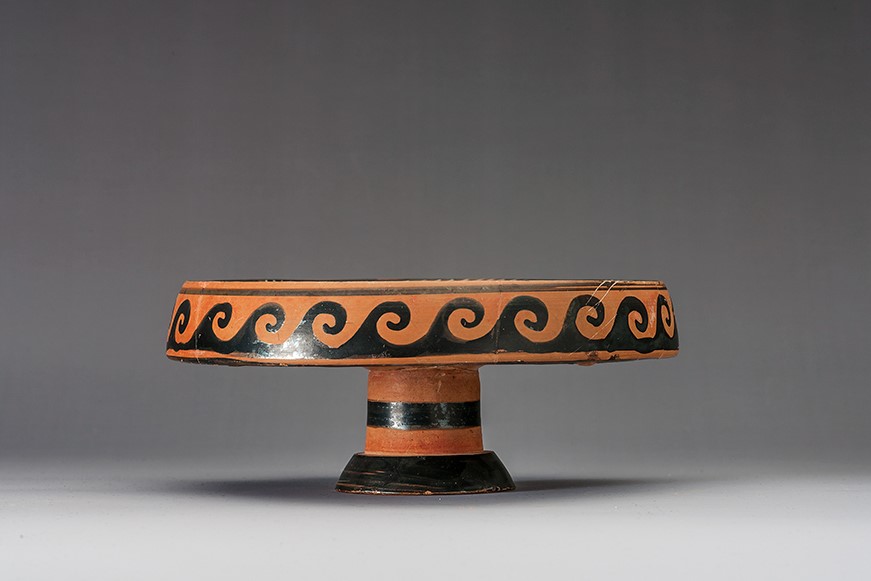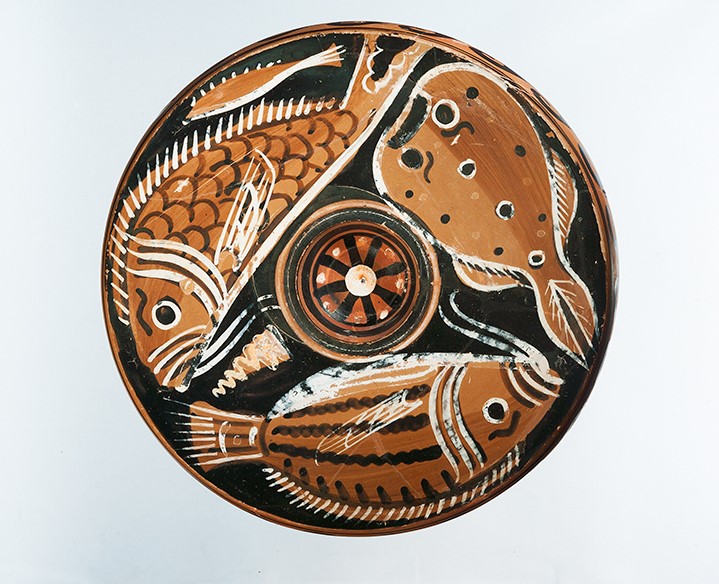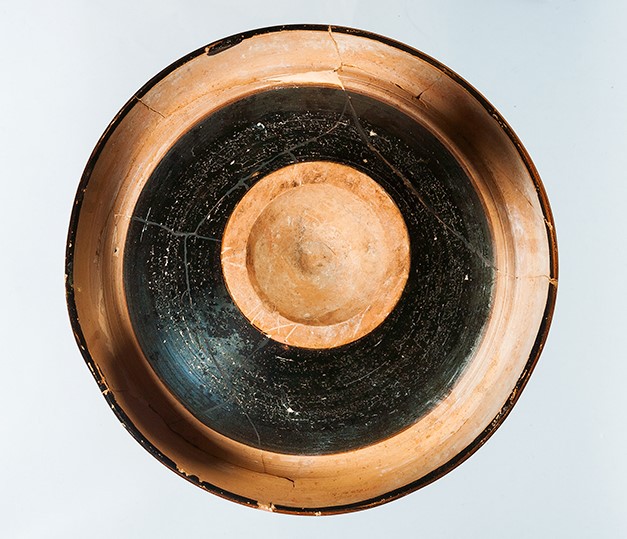Acquisition number: 1984.04
REPATRIATION CASE IN PROGRESS (for more information, please read our Collections Management Plan, or contact classics.museum@anu.edu.au )
Apulian Red-Figure Fish-Plate.
Recomposed from fragments but without serious restoration or repainting. A ring-mark on the upper face is evidence that another vase was stacked on top of this in the kiln.
Pale brown clay without obvious inclusions apart from some fine traces of mica. The upper face of the dish slopes down to a roughly hemispherical depression in the centre, marked off by a groove and ridge.
Somewhat metallic black glaze, rather uneven on the upper face. On the upper face are depicted a torpedo, striped perch and mullet; there is also a small fish, and a horn-shell. Details are picked out in white and a wash of dilute glaze was applied over the upper parts of the fish. The white is matt; a yellow wash was applied over it only in the case of the shell. The central depression is decorated with four crossed strokes of black with white dots between and a large white dot in the centre. Wave pattern decorates the vertical edge of the lip. There is a broad band of black on the underside of the plate, a band on the stem and another on the outer face of the foot (the resting surface and the underside are reserved).
Reddening was applied to the vertical face of the lip, to the lower wall and the outer face of the foot. The central area was reddened after the application of the white.
On the resting surface of the foot is a graffito which appears to be ancient:
IXII L´
Title: Apulian Red-Figure Fish-Plate - 1984.04
Acquisition number: 1984.04
Attribution: The Eyebrow Painter.
Author or editor: J.R. Green
Culture or period: Apulian Red-Figure.
Date: Late 4th century BC.
Material: Clay - Terracotta
Object type: Pottery - Red-figure
Dimensions: 216mm (w) × 91mm (h)
Origin region or location: Italy
Origin city: Apulia.
Display case or on loan: 8
Keywords: Apulian, Red Figure, Eyebrow Painter, Baltimore Painter, Graffito
I. McPhee and A.D. Trendall, Greek Red-FiguredFish-Plates (Antike Kunst 14. Beiheft, Basle 1987) 141 no. IV B 76, pl. 60f.
1984.04
Apulian Red-Figure Fish-Plate
Purchased. Ht 9.1cm; max. diam. 21.6cm.
Recomposed from fragments but without serious restoration or repainting. A ring-mark on the upper face is evidence that another vase was stacked on top of this in the kiln.
Pale brown clay without obvious inclusions apart from some fine traces of mica. The upper face of the dish slopes down to a roughly hemispherical depression in the centre, marked off by a groove and ridge.
Somewhat metallic black glaze, rather uneven on the upper face. On the upper face are depicted a torpedo, striped perch and mullet; there is also a small fish, and a horn-shell. Details are picked out in white and a wash of dilute glaze was applied over the upper parts of the fish. The white is matt; a yellow wash was applied over it only in the case of the shell. The central depression is decorated with four crossed strokes of black with white dots between and a large white dot in the centre. Wave pattern decorates the vertical edge of the lip. There is a broad band of black on the underside of the plate, a band on the stem and another on the outer face of the foot (the resting surface and the underside are reserved).
Reddening was applied to the vertical face of the lip, to the lower wall and the outer face of the foot. The central area was reddened after the application of the white.
On the resting surface of the foot is a graffito which appears to be ancient:
IXII L´
(see images)
The function of the so-called fish-plate is debated. On the basis of their decoration they are commonly believed to have been for fish, with the depression in the centre designed either to hold sauce or to collect the liquids. A late-third century example was found at Kition in Cyprus still holding snails (Bulletin de Correspondance Hellénique 106, 1982, 726 fig. 94), and this too is a likely use on appropriate occasions. The shape became very widespread in the Hellenistic period in the Near East where it must have had a wide range of functions.
The vase is attributed to an artist named the Eyebrow Painter who seems to have been located in the workshop of the Baltimore Painter (see A.D. Trendall, The Red Figure Vases of South Italy and Sicily. A Handbook [London 1989] 100-101). He has been given his name from the eyebrow-like lines which appear above the eyes of his fish; the eye itself is characteristically drawn as a solid black disc with a white outline; also characteristic is the torpedo with its open mouth; he normally draws a rosette in the depression of the plate. The painter is contemporary with later followers of the Baltimore Painter, probably in the last two decades of the fourth century BC. The plate is quite close to another formerly in the Cutler collection in Scottsdale, Arizona, which has a very similar mullet with scales shown and serrated tail-fin. The striped perch and the mullet have slightly less close parallels on a plate in the Macinagrossa collection in Bari (I. McPhee and A.D. Trendall, Greek Red-FiguredFish-Plates [Antike Kunst 14. Beiheft, Basle 1987] pl. 60e). The vase was made in Canosa in northern Apulia.
On fish and their depictions in the ancient world, see J. Delorme and Ch. Roux, Guide illustré de la faune aquatique dans l’art grec (Juan-les-Pins 1987); N. Kunisch, Griechische Fischteller. Natur und Bild (Kunstsammlungen der Ruhr-Universität Bochum, Berlin 1989). For discussion of the types of fish, see also H. Metzger, Revue des Études Grecques 103, 1990, 673-683; Ch. Roux, Revue des Études Grecques 105, 1992, 168-175.
On South-Italian fish-plates, see in the first instance the book by McPhee and Trendall mentioned below, and then I. McPhee and A.D. Trendall, “Addenda to Greek Red-Figured Fish Plates”, Antike Kunst 33, 1990, 31-51; A.D. Trendall, “New South Italian Fish-Plates in Sorengo and Elsewhere”, Numismatica ed Antichità Classica. Quaderni Ticinesi 21, 1992, 105-130. The latter article includes two further works by the Eyebrow Painter. See also Chr. Zindel, Meeresleben und Jenseitsfahrt. Die Fischteller der Sammlung Florence Gottet (Kilchberg 1998, second ed. 2008) (on this collection see also F. Hildebrandt and VB.C. Kottsieper, Antike Welt 35.3, 2004, 62-64; M. Kunze, Die Griechen und das Meer [Stendal 2010]); M. Recke (ed.), Antike, Fische, Teller : die Fischteller der Sammlung Neumann zu Gast bei den Fischen in der Antikensammlung der Universität Gießen (Gießen 2008); and K. Schauenburg, Studien zur unteritalischen Vasenmalerei I (Kiel 1999) 33-43. There is also a brief overview by C. Lambrugo, “I piatti da pesce: gastronomia e pittura”, in: G. Sena Chiesa and E.A. Arslan (eds), Miti greci. Archeologia e pittura dalla Magna Grecia al collezionismo (Milan 2004) 186-187.
On those manufactured in Campania and Sicily, see F. Mollo, “Tra Sicilia e Campania. Osservazioni sui contesti di provenienza e sull’iconografia dei piatti da pesce del basso Tirreno”, Sicilia Antiqua 4, 2007, 65-86; id., “Attestazioni di piatti da pesce dalla Calabria: alcune riflessioni tra produzione ed iconografia”, in: G. Lena (ed.), Ricerche storiche in Calabria, modelli e prospettive (Cosenza 2008) 131-142. There was also a more limited production of them at Cerveteri in Etruria: M.A. Del Chiaro, “Etruscan (Caeretan) Red-Figured Fish Plates”, Jahreshefte des Oesterreichischen Archäologischen Institutes 51, 1976-77, 11-17.
On the earlier black-glazed versions in Athens, see R. Lindner, “Attischer Fischteller”, Archäologischer Anzeiger 1985, 251-254.
A. Palombi and M. Santarelli, Gli animali comestibili dei mari d'Italia (Milan 1969) provide an interesting catalogue of the fish, their habitats and qualities. They think little of the torpedo on account of its soft, insipid flesh. Fish was of course a favourite food in much of the ancient world: E. Salza Prina Ricotti, “L’importanza del pesce nella vita, nel costume e nell’industria del mondo antico”, Atti della Pontificia Accademia Romana di Archeologia, Rendiconti 71, 1998-99, 111-165; D. Mylona, Fish-Eating in Greece from the Fifth Century B.C. to the Seventh Century A.D. (BAR Int. Series 1754, Oxford 2008).
Perhaps because of the popularity of these vases among private collectors, there has also been a worrying number of fakes: see for example the comments of M. Christidis, “Echt? – Fischteller aus Privatsammlungen”, Forum Archaeologiae 74/III/2015 (http://farch.net).
I. McPhee and A.D. Trendall, Greek Red-FiguredFish-Plates (Antike Kunst 14. Beiheft, Basle 1987) 141 no. IV B 76, pl. 60f.


